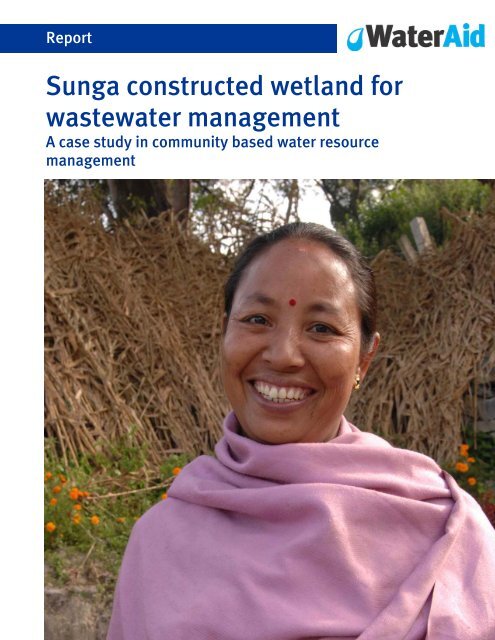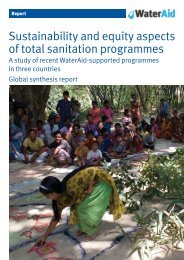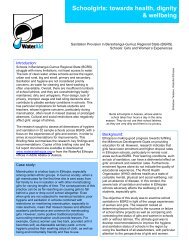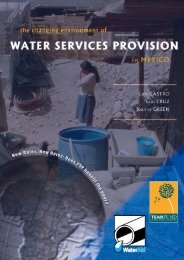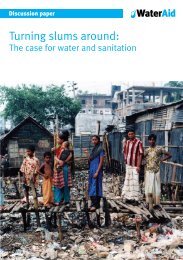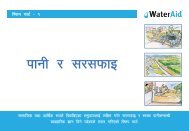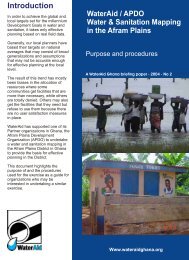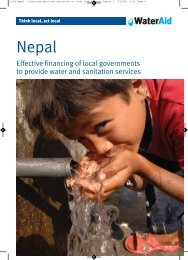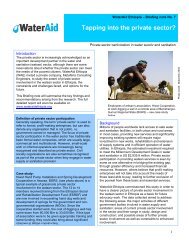Sunga constructed wetland for wastewater management
Sunga constructed wetland for wastewater management
Sunga constructed wetland for wastewater management
You also want an ePaper? Increase the reach of your titles
YUMPU automatically turns print PDFs into web optimized ePapers that Google loves.
to use the reeds <strong>for</strong> fencing the treatment plant to restrict unauthorised entry. Ifthere is any surplus, they can also be used as a source of energy <strong>for</strong> burning.Benefits to the communityThe site where the <strong>wastewater</strong> treatment plant has been <strong>constructed</strong> waspreviously used <strong>for</strong> dumping of solid waste and open defecation by thecommunity. However, after the construction and operation of the treatment plant,the surrounding environment has improved to a large extent. This has benefitednot only the community but also the school children. This improvement has thusdiscouraged other people to continue with the traditional habit of defecation andwaste dumping. The entire area now seems to be healthier and aestheticallyattractive with an enhanced environment.Demonstration siteThe <strong>Sunga</strong> <strong>constructed</strong> <strong>wetland</strong> has received attention from different national andinternational visitors, policy makers, researchers, professionals, students andjournalists, who have visited this site to observe and share experiences oncommunity based <strong>wastewater</strong> treatment plant <strong>for</strong> replication, research andknowledge. The <strong>management</strong> committee and ENPHO have received positivefeedbacks from all the visitors. Besides, these visits have also helped in raisingawareness of this simple technology and the role of communities in municipal<strong>wastewater</strong> <strong>management</strong>. The plant is as an example of the first community basedtreatment plant in Nepal and is gradually proving itself as a demonstration unit <strong>for</strong>people from various parts of the country and abroad.Visits from other communities/municipalitiesThis system has also been able to establish itself as a demonstration site <strong>for</strong> theADB funded Urban and Environmental Improvement Project which is planning toestablish similar treatment plants in eight municipalities of Nepal. In addition tothis, this system has also attracted many visitors from WaterAid countryprogrammes, particularly from the Asia region and from WaterAid in the UK, toshare experiences.8
ConclusionThe growing trend of urbanisation is increasing the level of land and waterpollution. If the untreated <strong>wastewater</strong> continues to increase at its current rate, theadverse impacts on these rivers make them unusable thereby destroying thecurrent eco-system of fresh water bodies.The <strong>Sunga</strong> <strong>constructed</strong> <strong>wetland</strong> is a clear demonstration of the effectiveness of thecommunity based <strong>wastewater</strong> <strong>management</strong> project and its contribution. Thedesign of this project has many advantages such as easy operation andmaintenance; adaptability in a small area compared to conventional system;working efficiency; water optimisation; recycle and reuse of the treated effluentfrom <strong>wastewater</strong>; and income and livelihood opportunities. In addition, the projecthas also become successful in enhancing the river quality and ensuring benefits tothe community dwellers.This project is an example of an approach towards the sustainable <strong>management</strong> ofwater and <strong>wastewater</strong>. This has inspired people to adopt this type of technologythat can be managed by the community itself <strong>for</strong> the solution of currentlymis-managed <strong>wastewater</strong> in the city.9
WaterAid’s mission is to overcome poverty byenabling the world’s poorest people to gain access tosafe water, sanitation and hygiene education.WaterAid in NepalShanta Bhawan, Lalitpur, NepalPO Box 20214, Kathmandu, NepalTel: (977-1) 5552764; 5552765Fax: (977-1) 5547420Email: wateraid@wateraidnepal.org.np


